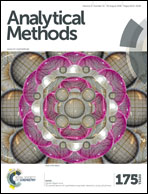An ultrasensitive label-free immunoassay for C-reactive protein detection in human serum based on electron transfer†
Abstract
A rapid, ultrasensitive, and practical label-free electrochemical immunoassay for measuring C-reactive protein (CRP) in real serum samples was developed. Molybdenum disulfide–polyaniline–gold nanoparticles (MoS2–PANI–GNPs) with high conductivity were employed as the substrate to assist the electron transfer. Compared with a bare electrode, an about 10-fold increase in the peak current could be detected for MoS2–PANI–GNPs. Moreover, MoS2–PANI–GNPs which have abundant adsorbing sites and a large surface area could greatly increase loading amounts of antibodies and thus, significantly improve the performance of biosensing. Under optimized experimental conditions, the proposed sensing strategy provides a linear dynamic range from 0.2 to 80 ng mL−1 and a detection limit of 40 pg mL−1. The proposed immunosensor has also been used to determine CRP in human serum with satisfactory results. This possibly makes it an attractive platform in bioanalysis of proteins and other molecules.


 Please wait while we load your content...
Please wait while we load your content...